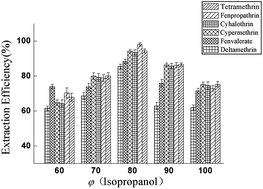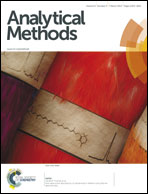A highly efficient extraction, separation and detection method for pyrethroids in pork using the interaction between pyrethroids and protein†
Abstract
In pork samples, the extraction efficiency of pyrethroids was related to the interactions between pyrethroids and proteins. These interactions were explored using the fluorescence quenching method. This showed that the binding interactions between pyrethroids and proteins are strongly hydrophobic. It was found that a slow but full protein denaturation took place in the 80% (volume fraction) isopropanol (IPA) aqueous solution, causing protein unfolding and the release of pyrethroids. Based on this, a highly efficient extraction method for pyrethroids in pork samples is proposed using 80% IPA solution as extraction solvent. A clean-up step using primary secondary amine (PSA) was applied, followed by the final determination by gas chromatography (GC) with an electron capture detector (ECD). The analytical process was validated in the pork sample matrix by analysing spiked blank samples. The mean recoveries of this method were 79.0–90.5% with limits of detection (LOD) between 0.008 and 0.014 μg g−1. This paper proposes a new strategy by full denaturation of protein and releasing of bound drugs to enhance the extraction efficiency of pyrethroids in pork samples.


 Please wait while we load your content...
Please wait while we load your content...